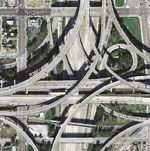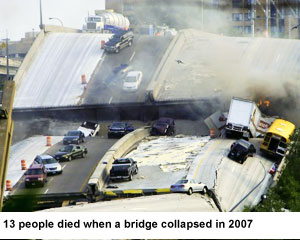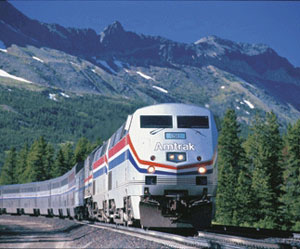
Highway interchange in Los Angeles: The LA bus system is not convenient for riders stuck in traffic

FRONT PAGE
Site Search
About us
 

US transportation debate
US transportation and the economy
Drones over US cities
US public bus systems
US public transport use
Bus Rapid Transport Latin America
Canada high-speed rail
Bus Rapid Transport India
US car parks
Cycling in US cities
Road tolls in cities worldwide
Issues facing megacities
Most polluted US cities
Road traffic kills children
US built environment in 2030
Urban pollution

Worldwide | Elections | North America | Latin America | Europe | Asia | Africa |


























|
|
US mayors lobby federal government
for fully funded transportation policies
By Tony Favro, USA Editor*
13 October 2011: In September 2011, a group of 50 US mayors traveled to Washington, DC to speak with federal officials about funding for transportation projects. The nation’s omnibus transportation bill was set to expire in ten days, and the mayors, led by Mayor Antonio Villaraigosa of Los Angeles, Mayor Michael Nutter of Philadelphia, and Mayor Elizabeth Kautz of Burnsville, Minnesota, lobbied for a “comprehensive, fully funded” successor.
• Fiscal uncertainty
• Waste or investment?
• Local implications
• Mayors create opportunity
The bill, called SAFETEA-LU for the Safe, Accountable, Flexible, Efficient Transportation Equity Act: A Legacy for Users, was originally enacted in 2005 and expired in 2009, but financing was continued through a series of seven extensions since then. SAFETEA-LU guarantees funding to state and local governments for highways and public transit and responds to such challenges as safety, traffic congestion, freight movement, intermodal connectivity, and environmental protection.
Just before its expiration date, Congress voted to extend SAFETEA-LU for an eighth time. The six-month extension to 31 March 2012 continues an 18.4 cents per gallon federal tax on gasoline, the main revenue source for federal highway projects. The extension also maintains federal spending for surface transportation at current levels.
The short-term extension is widely viewed as a “quick fix” to addressing the impacts on the transportation system of an aging population, aging roads and bridges, climate change, volatile energy prices, and constrained public budgets at every level of government, all of which are more pronounced than ever. Fitch Ratings dismissed the extension of SAFETEA-LU as a “stop-gap” measure and called for a sustainable, long-term solution to the nation’s transportation-related problems.
Mayors throughout the country have held public events to call attention to the importance of both a comprehensive approach to transportation planning and adequate funding for improvements. Mayor Greg Fischer of Louisville, Kentucky led a tour of a major bridge in his city, pointing out cracked and weakened steel to television crews. A group of Illinois mayors, including Dale Berman of North Aurora, Kevin Burns of Geneva, Gary Golinski of Yorkville, Brian LeClerq of Oswego, Marilyn Michelini of Montgomery, and Jeff Schielke of Batavia, held a news conference with other local leaders to get the word out that municipalities and businesses need long-term “certainty” regarding what the federal government will spend on transportation.
 Fiscal uncertainty Fiscal uncertainty
Hurricane Katrina in 2005 and the collapse of an eight-lane bridge into the Mississippi River in Minneapolis in 2007 dramatized for Americans that regular maintenance and replacement of infrastructure is far cheaper than rebuilding after a disaster.
However, the lesson was short-lived. Public support for investment in infrastructure seems to erode as the economic recession drags on. In 2010, voters elected new members of Congress devoted to shrinking the size of government, reducing the federal deficit, and cutting “waste” at all costs. The nation’s strained transportation infrastructure became a political football for Congress.
Many Congressional Democrats are pushing for an increase in the gas tax to fund repairs to roads and bridges. The gas tax has been level since 1993 and funds only 65 per cent of SAFETEA-LU; the balance of revenues must be found elsewhere in the federal budget. Support for raising the gas tax comes from the American Truckers Association and the American Automobile Association, who point out that smooth roads lead to lower shipping costs and greater fuel efficiency. However, 75 per cent of Americans oppose raising the gas tax, according to poll by Reuters/IPSOS, as do Congressional Republicans.
Republicans in Congress are pushing for a six-year transportation bill that limits spending only to the amount of revenues that can be raised through the current gas tax. This would effectively cut spending for transportation by nearly 35 per cent. Democrats prefer a two-year bill at today’s spending levels. Complicating the debate are a least two proposals to create a national bank to finance investments in infrastructure, including transportation, as well a proposal by President Obama and another by the US Conference of Mayors to stimulate job growth partly through federal investment in transportation projects.
Money is not the only roadblock. Political differences are also stalling work on a successor to SAFETEA-LU.
 Waste or investment? Waste or investment?
Waste or investment? Debate on transportation frequently divides along these lines.
Republicans in Congress are targeting what they call “wasteful” subsidies for rail transportation, particularly elimination of the $1.5 billion annual subsidy for Amtrak, the national passenger rail service. Amtrak is owned by the federal government, but operates mostly on track owned by private cargo railroads. Some of Amtrak’s lines in the busy travel corridors between New York, Philadelphia, Boston, and Washington, DC show a slight profit, but most routes are money-losers. On average, Amtrak loses about $30 per passenger, but provides an alternative to congested airports and intrusive airport security checks.
Americans, however, have shown little support for national rail service of any kind. President Obama’s proposal to invest $53 billion over the next six years to build an intercity high-speed rail network failed to gain traction with the general public. Recession-weary Americans were put off by the price tag (never mind that it would cost less than six weeks of war in Afghanistan and Iraq), and found it difficult to understand why high-speed rail was a necessary investment when they can already fly to distant parts of the country far more quickly. Many Democrats who initially supported high-speed rail have since backed off.
Republicans also seek to cut federal funds for public bus, light rail, and subway systems by as much as 30 per cent, which could result in fare increases and service reductions. Washington, DC’s metro system, for example, would lose the $150 million it receives each year from the federal government under Republican proposals, which Democrats are resisting.
Local implications
The rather simplistic debates at high levels of government, like wasteful spending versus necessary investment, sometimes result in complicated situations for mayors and cities. Los Angeles offers insight into how the political debates and funding cuts may shape public transit in the United States.
In response to state and projected federal budget cuts, the Los Angeles transit system has approved plans to significantly rollback bus service for the second time in two years. Twelve per cent of all bus routes will be eliminated, and the bus fleet reduced to its smallest size since the 1980s. Los Angeles also has light-rail service. Buses serve 80 per cent of transit riders, but take up only 35 per cent of the transit system’s operating budget.
In Los Angeles, it costs three times as much to serve the same number of passengers by rail as by bus, yet Mayor Villaraigosa has supported expanding the light rail network even while bus service is being reduced. According to Villaraigosa, the bus system is not convenient for riders stuck in traffic, and Los Angeles is in “obvious need” of increased light rail options to help manage the city’s infamous traffic congestion and facilitate personal mobility.
Civil rights law in the United State prohibits discrimination in any program or service that receives federal funds, including public transit. In Los Angeles, low-income bus riders have asked the federal government to investigate whether the proposed bus service reductions in the face of rail expansion disproportionately affect poor, minority riders, most of whom take the bus. If the proposed rollbacks are found to violate civil rights law, the Los Angeles transit system would face federal sanctions. This wouldn't be the first time Los Angeles faced sanctions. In 1994, a group called the Bus Riders' Union successfully sued the transit system for reducing bus service in poor, working class communities, far away from a new multi-billion dollar rail line that was under construction. As a result, the courts mandated a certain level of bus service, and Los Angeles became nationally recognized for its service improvements.
Los Angeles is only the most prominent example of the difficult choices that mayors and public transit operators are forced to make. In a less volatile world, improvements in one area of public transportation would complement improvements in other areas, not replace or shortchange them. As federal and state transportation budgets get slashed, this option is not always available.
Mayors create opportunity
Mayors and others realize that the political rancor, limited financial resources, and scant public support for increased spending, presents them with an opportunity to be proactive in reappraising how the nation approaches its transit needs. When money is short, every dollar must be spent wisely, and mayors and local governments in the US — operating under austerity for the past decade or more — are accustomed to ensuring that whatever funding is available is used in ways that deliver maximum public benefits.
Former Detroit Mayor Dennis Archer is chair of the National Transportation Policy Project, a bipartisan coalition of transportation policy experts and business and civic leaders. The coalition worked with the National League of Cities and others to craft what Mayor Archer calls, “a programmatic framework for federal transportation spending” based on current levels of revenues but targeted more strategically. Specifically, Archer says that the coalition’s policy framework links “transportation spending to broader national goals, including economic growth, connectivity, accessibility, safety, energy security and environmental protection.”
Next year is a presidential election year in the United States, and the prospects for bipartisanship in Congress are probably not good. But the American economy depends on a healthy transportation infrastructure, and mayors are keeping pressure on federal policymakers to commit to both plan and build a transportation system that meets future needs and challenges.
*Tony Favro’s latest book Hard Constants: Sustainability and the American City is now available free of charge from City Mayors. Please complete our order form to receive a pdf copy. Libraries of academic institutions may receive a hard copy. Order form
|
|

|



































